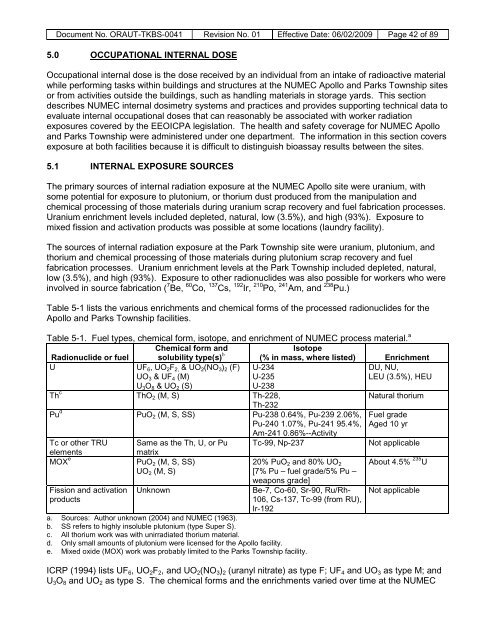ORAU TEAM Dose Reconstruction Project for NIOSH
ORAU TEAM Dose Reconstruction Project for NIOSH
ORAU TEAM Dose Reconstruction Project for NIOSH
You also want an ePaper? Increase the reach of your titles
YUMPU automatically turns print PDFs into web optimized ePapers that Google loves.
5.0<br />
Document No. <strong>ORAU</strong>T-TKBS-0041 Revision No. 01 Effective Date: 06/02/2009 Page 42 of 89<br />
OCCUPATIONAL INTERNAL DOSE<br />
Occupational internal dose is the dose received by an individual from an intake of radioactive material<br />
while per<strong>for</strong>ming tasks within buildings and structures at the NUMEC Apollo and Parks Township sites<br />
or from activities outside the buildings, such as handling materials in storage yards. This section<br />
describes NUMEC internal dosimetry systems and practices and provides supporting technical data to<br />
evaluate internal occupational doses that can reasonably be associated with worker radiation<br />
exposures covered by the EEOICPA legislation. The health and safety coverage <strong>for</strong> NUMEC Apollo<br />
and Parks Township were administered under one department. The in<strong>for</strong>mation in this section covers<br />
exposure at both facilities because it is difficult to distinguish bioassay results between the sites.<br />
5.1 INTERNAL EXPOSURE SOURCES<br />
The primary sources of internal radiation exposure at the NUMEC Apollo site were uranium, with<br />
some potential <strong>for</strong> exposure to plutonium, or thorium dust produced from the manipulation and<br />
chemical processing of those materials during uranium scrap recovery and fuel fabrication processes.<br />
Uranium enrichment levels included depleted, natural, low (3.5%), and high (93%). Exposure to<br />
mixed fission and activation products was possible at some locations (laundry facility).<br />
The sources of internal radiation exposure at the Park Township site were uranium, plutonium, and<br />
thorium and chemical processing of those materials during plutonium scrap recovery and fuel<br />
fabrication processes. Uranium enrichment levels at the Park Township included depleted, natural,<br />
low (3.5%), and high (93%). Exposure to other radionuclides was also possible <strong>for</strong> workers who were<br />
involved in source fabrication ( 7 Be, 60 Co, 137 Cs, 192 Ir, 210 Po, 241 Am, and 238 Pu.)<br />
Table 5-1 lists the various enrichments and chemical <strong>for</strong>ms of the processed radionuclides <strong>for</strong> the<br />
Apollo and Parks Township facilities.<br />
Table 5-1. Fuel types, chemical <strong>for</strong>m, isotope, and enrichment of NUMEC process material. a<br />
Chemical <strong>for</strong>m and<br />
Radionuclide or fuel solubility type(s) b<br />
Isotope<br />
(% in mass, where listed) Enrichment<br />
U UF6, UO2F2, & UO2(NO3)2 (F)<br />
UO3 & UF4 (M)<br />
U-234<br />
U-235<br />
DU, NU,<br />
LEU (3.5%), HEU<br />
Th<br />
U3O8 & UO2 (S)<br />
U-238<br />
c ThO2 (M, S) Th-228,<br />
Th-232<br />
Natural thorium<br />
Pu d PuO2 (M, S, SS) Pu-238 0.64%, Pu-239 2.06%,<br />
Pu-240 1.07%, Pu-241 95.4%,<br />
Am-241 0.86%--Activity<br />
Fuel grade<br />
Aged 10 yr<br />
Tc or other TRU Same as the Th, U, or Pu Tc-99, Np-237 Not applicable<br />
elements<br />
matrix<br />
MOX e PuO2 (M, S, SS)<br />
UO2 (M, S)<br />
20% PuO2 and 80% UO2<br />
[7% Pu – fuel grade/5% Pu –<br />
weapons grade]<br />
About 4.5% 235 U<br />
Fission and activation Unknown Be-7, Co-60, Sr-90, Ru/Rh- Not applicable<br />
products<br />
106, Cs-137, Tc-99 (from RU),<br />
Ir-192<br />
a. Sources: Author unknown (2004) and NUMEC (1963).<br />
b. SS refers to highly insoluble plutonium (type Super S).<br />
c. All thorium work was with unirradiated thorium material.<br />
d. Only small amounts of plutonium were licensed <strong>for</strong> the Apollo facility.<br />
e. Mixed oxide (MOX) work was probably limited to the Parks Township facility.<br />
ICRP (1994) lists UF6, UO2F2, and UO2(NO3)2 (uranyl nitrate) as type F; UF4 and UO3 as type M; and<br />
U3O8 and UO2 as type S. The chemical <strong>for</strong>ms and the enrichments varied over time at the NUMEC

















